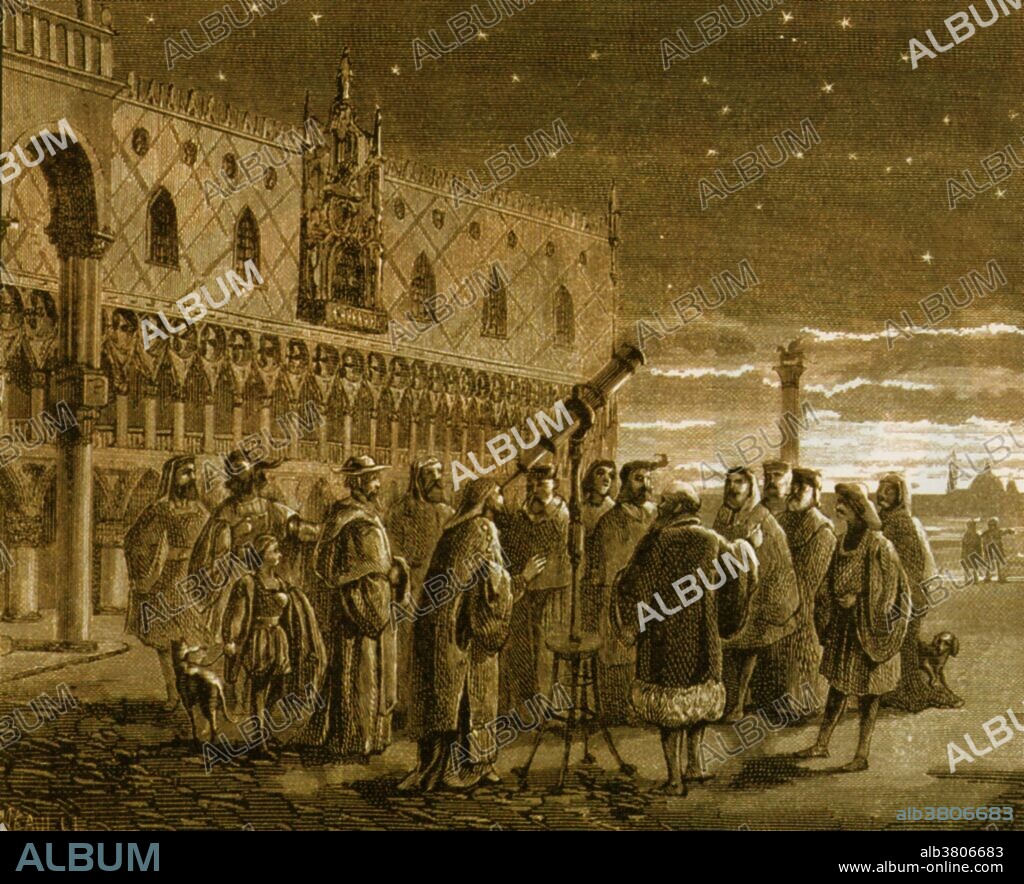alb3806683
Galileo Galilei Demonstrating His Telescope, 1609

|
Add to another lightbox |
|
Add to another lightbox |



Buy this image.
Select the use:

Title:
Galileo Galilei Demonstrating His Telescope, 1609
Caption:
Galileo and his telescope in Venice. 1609. Galileo shows the satellites of Jupiter to Venetian senators. Galileo Galilei (February 15, 1564 - January 8, 1642) was an Italian physicist, mathematician, astronomer, and philosopher who played a major role in the Scientific Revolution. His achievements include improvements to the telescope, important astronomical observations and support for Copernicanism. Galileo has been called the "father of modern observational astronomy", the "father of modern physics", the "father of science", and "the Father of Modern Science". In 1610 he became the first person to use a telescope to make astronomical observations. He discovered the mountains on the Moon, the four largest moons of Jupiter and numerous dim stars. He studied the motion of a pendulum and found that the swings have a constant time period. He studied gravity, showing that heavy and light objects fall at the same rate. He supported the Copernican theory that the Sun was at the center of the solar system rather than the Earth. This belief was judged heretical by the Inquisition in 1633 and he was sentenced to house arrest for the rest of his life. Suffering fever and heart palpitations, he died in 1642, at the age of 77.
Credit:
Album / Science Source / New York Public Library
Releases:
Model: No - Property: No
Rights questions?
Rights questions?
Image size:
3640 x 2955 px | 30.8 MB
Print size:
30.8 x 25.0 cm | 12.1 x 9.8 in (300 dpi)
Keywords:
1564 • 16 16TH XVI XVITH SIXTEENTH CENTURY • 16 CENTURY • 1609 • 1642 • 16TH CENTURY • 16TH • 17TH CENTURY • ART • ARTWORK • ASTRONOMER • ASTRONOMY • CELEBRITIES • CELEBRITY • COLORIZED • COSMOLOGIST • COSMOLOGY • DRAWING • ENGRAVING • ENHANCEMENT • FAMOUS PEOPLE • FAMOUS • FATHER OF MODERN PHYSICS • FATHER OF MODERN SCIENCE • FATHER OF SCIENCE • FIGURE • GALILEI • GALILEI, GALILEO • GALILEO GALILEI • GALILEO • HERETIC • HISTORIC • HISTORICAL • HISTORY • ILLUSTRATION • ILLUSTRATIONS • IMPORTANT • INFLUENTIAL • INQUISITION • JUPITER'S MOONS • JUPITER • JUPITERS MOONS • MALE • MAN • MATHEMATICAL • MATHEMATICIAN • MEN • NOTABLE • OBSERVATIONAL ASTRONOMER • OBSERVATIONAL ASTRONOMY • PEOPLE • PERSON • PERSONALITY • PHILOSOPHER • PHYSICIST • PHYSICS • POLYMATH • RENOWNED • SATELLITES • SAVANT • SCIENCE • SCIENTIFIC REVOLUTION • SCIENTIFIC • SCIENTIST GALILEI • SCIENTIST • SENATORS • TELESCOPE • VENECIA • VENETIAN • VENEZIA • VENICE • VENICE, ITALY • WELL-KNOWN • XVI CENTURY • ZEUS
 Pinterest
Pinterest Twitter
Twitter Facebook
Facebook Copy link
Copy link Email
Email
